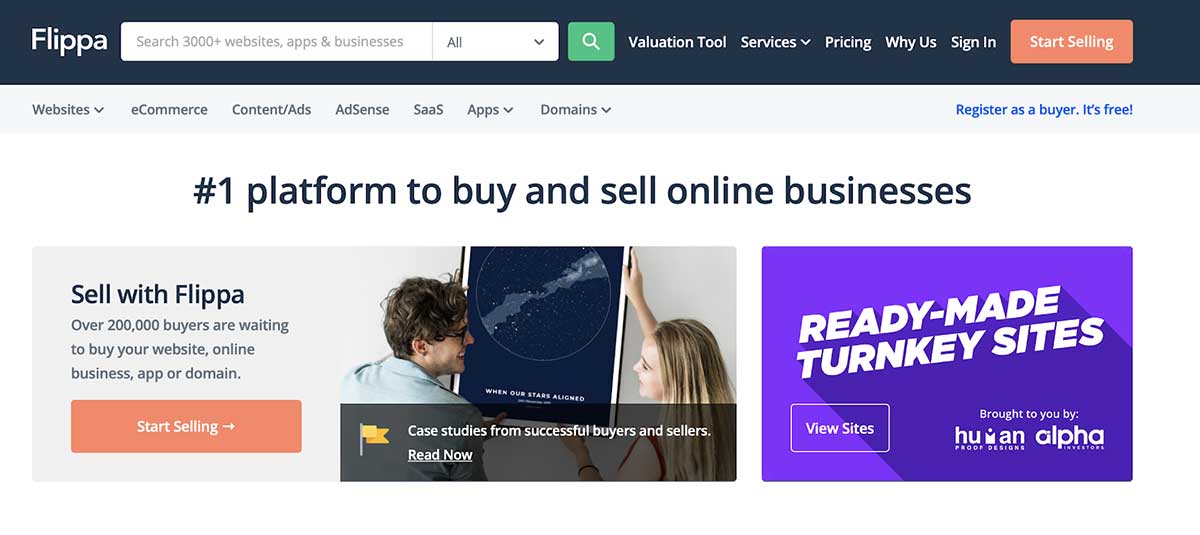Introduction: Discovering the World of Online Business Marketplaces
As someone who’s spent years navigating the unpredictable terrain of digital entrepreneurship, I’ve always been on the hunt for tools that simplify the process of buying or selling online ventures. That’s when I stumbled upon Flippa —a platform that promised to bridge the gap between sellers looking to cash out and buyers hungry for turnkey opportunities. Skeptical at first (after all, the internet is full of overhyped platforms), I decided to dive in. Fast forward to today, and Flippa has become an indispensable part of my entrepreneurial toolkit. Here’s why.
What Makes Flippa Stand Out?
The online business marketplace is crowded, but Flippa distinguishes itself in three key ways:
- Scale and Diversity: With over 6,000 active listings at any given time, Flippa isn’t just a marketplace—it’s a universe of opportunities. Whether you’re eyeing a niche blog generating $500/month or a seven-figure SaaS startup, the platform caters to all budgets and ambitions. I’ve personally browsed listings for everything from Amazon FBA stores to AI-powered apps, and the sheer variety is staggering.
- Transparency and Trust: Unlike shady “get-rich-quick” forums, Flippa enforces rigorous due diligence. Sellers must disclose traffic stats, revenue proofs, and operational details. During my first purchase—a content website—the seller provided Google Analytics access upfront, which eliminated guesswork and built immediate confidence.
- Speed and Accessibility: Listing a business takes minutes, not days. The free valuation tool (a godsend for newbies) gave me a ballpark figure for my side hustle’s worth, and within 48 hours, I had serious offers. For impatient entrepreneurs like me, this efficiency is golden.
My First-Hand Experience: Selling a Dropshipping Store
Last year, I decided to sell a dropshipping store I’d built during the pandemic. Here’s how Flippa turned a stressful process into a smooth transaction:
- Free Valuation: The platform’s algorithm analyzed my revenue streams, traffic sources, and growth trends to suggest a listing price of $28,000. This grounded my expectations and attracted serious buyers.
- Broker Matching: Flippa’s broker network connected me with an expert in eCommerce exits. Their guidance on optimizing my listing (e.g., highlighting supplier relationships and customer retention rates) was invaluable.
- Bidding War: Within a week, three buyers were actively bidding. The transparent comment section allowed me to address questions publicly, reducing back-and-forth emails. The store sold for $31,500—a 12% premium over my ask.
This experience solidified my belief in Flippa’s ability to maximize value for sellers.
Buying Opportunities: How I Snagged a Profitable Blog
On the flip side, I’ve also acquired assets through Flippa. My favorite purchase? A travel blog that was netting $1,200/month but had stagnated due to the owner’s burnout. Here’s what worked:
- Filtering Tools: I narrowed down listings using criteria like “verified revenue” and “age of domain.” The blog popped up with two years of consistent earnings and a clean backlink profile.
- Escrow Protection: Flippa’s escrow service held my payment until the domain and content were transferred. No horror stories of vanished sellers!
- Post-Sale Support: The seller shared a detailed SOP document, making the transition seamless. Six months later, after tweaking the SEO strategy, the blog now earns $2,300/month.
The Pros and Cons: A Balanced Perspective
No platform is perfect, but Flippa ’s strengths far outweigh its weaknesses:
Pros:
- Global Reach: Buyers and sellers from 150+ countries.
- Low Barriers: Listings start at $15, democratizing access.
- Educational Resources: Webinars and guides on valuation and due diligence.
Cons:
- Overpriced Listings Exist: Some sellers inflate valuations, but the “verified” badge helps filter these out.
- Broker Fees: Premium services cost extra, though they’re often worth it for high-value deals.
Flippa vs. Competitors: Why It Wins
Having tried alternatives like Empire Flippers and Exchange Marketplace, I’ll stick with Flippa. Here’s why:
- Liquidity: Few platforms match Flippa’s 300,000+ buyer pool. Listings move faster here.
- Flexibility: Want to sell a domain alone? A Shopify store? Flippa handles it all. Empire Flippers focuses narrowly on “premium” businesses, shutting out smaller sellers.
- Cost-Effectiveness: Flippa’s success-based fees (10% for sales under $50k) beat competitors’ flat rates.
The Future of Online Business Sales: Why Flippa Is Ahead of the Curve
As remote work and AI-driven entrepreneurship explode, demand for turnkey digital assets will skyrocket. Flippa is positioned to dominate this space with innovations like:
- AI Valuation Tools: Instant estimates using machine learning.
- NFT Integration: Exploring blockchain for domain ownership transfers.
- Community Features: Forums where buyers and sellers collaborate pre-deal.
Final Thoughts: A Platform That Empowers Digital Dreams
Whether you’re a serial entrepreneur or a first-time buyer, Flippa offers the tools and transparency to turn aspirations into reality. It’s not just a marketplace—it’s a launchpad for the next generation of digital success stories.
Ready to dive in? Head to Flippa’s official website today and explore a world where your next big opportunity is just a click away.

